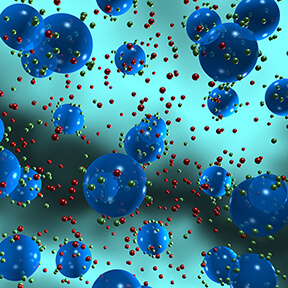March 7, 2017
Cells communicate better when not squeezed together, research shows
 Cells communicate by exchanging molecules, allowing either short- and long-range communication. Purdue University biophysicist Andrew Mugler discovered that, contrary to his hypothesis, long-range communication for the cells was more accurate. (Purdue University image by Ken Ritchie)
Download image
Cells communicate by exchanging molecules, allowing either short- and long-range communication. Purdue University biophysicist Andrew Mugler discovered that, contrary to his hypothesis, long-range communication for the cells was more accurate. (Purdue University image by Ken Ritchie)
Download image
WEST LAFAYETTE, Ind. — Scientists are beginning to realize that many cellular behaviors, such as metastasizing cancer cells moving through the body or wound healing, aren't random events, but the result of coordinated actions by cells.
Such collective cell movement requires communication, and a new study shows that cells are most effective at communication when they aren't tightly packed together. This was a surprise, says Andrew Mugler, a Purdue University assistant professor of physics and astronomy who studies cell behavior.
"Our hypothesis was proven wrong," Mugler says. "Our hypothesis was that cells that are closer to each other should experience a sensory improvement. Instead, we found that long-range communication was better, even though it meant that cells had to be receiving weaker communication signals."
"Long range" is a relative term when studying life at the microscopic level, but Mugler says the optimal range for small groups of cells, up to about 200 cells, was five cell diameters. For more than 1,000 cells the optimal range was more like 10-15 cell diameters.
Cells communicate in one of two ways: either by excreting messenger molecules, or by directly exchanging small molecules when closer together.
It turns out that the more direct method becomes less effective because a "telephone game" effect comes into play. But also, Mugler says, the more dispersed cells provide each other with a more accurate view of their environment.
"It would be as if you and I both had thermometers and wanted to measure the outdoor temperature," he says. "If we are standing right next to each other but we are both in the direct sunlight or in deep shade, we might not get an accurate reading.
"But if we're 50 feet apart, we can still communicate, but together we're more likely to measure an accurate temperature. The same effect happens at the cellular level."
Mugler says learning more about how cells communicate and organize will be important to gain a better understanding of many areas of medicine.
"We're studying collective sensing, but this is also important in collective movement, as you would see in embryonic development, wound healing and in cancer. We're learning that the way disease plays out often has a great deal to do with multicellular effects. As cells to go from a tumor-like state to a metastatic state, reaching other parts of the body often requires coordinated action. Cells leave the tumor and enter the bloodstream, and for certain cancers, this is a collective process."
The research was published recently in the journal Physical Review Letters. Mugler's graduate student Sean Fancher was the paper's lead author. The research was funded by the Simons Foundation.
Writer: Steve Tally, 765-494-9809, steve@purdue.edu, @sciencewriter
Source: Andrew Mugler, 765-496-3427, amugler@purdue.edu
ABSTRACT
Fundamental limits to collective concentration sensing in cell populations
Sean Fancher and Andrew Mugler, Purdue University, West Lafayette, Indiana, USA
The precision of concentration sensing is improved when cells communicate. Here we derive the physical limits to concentration sensing for cells that communicate over short distances by directly exchanging small molecules (juxtacrine signaling), or over longer distances by secreting and sensing a diffusive messenger molecule (autocrine signaling). In the latter case, we find that the optimal cell spacing can be large, due to a trade-off between maintaining communication strength and reducing signal cross-correlations. This leads to the surprising result that sparsely packed communicating cells sense concentrations more precisely than densely packed communicating cells. We compare our results to data from a wide variety of communicating cell types.

